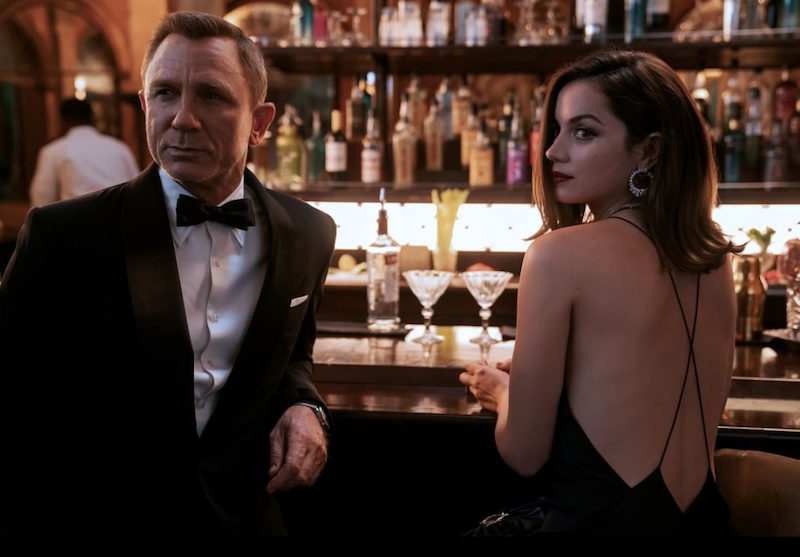Movie review: James Bond, No Time To Die
License expired…
You can tell a lot about a person by their response to the question ‘who is your favourite James Bond?’ Scientifically, it’s at least as accurate as astrology or BuzzFeed quizzes at predicting personality types. We won’t go into our theory about Pierce Brosnan fans, but if Daniel Craig’s Bond is your pick for Golden Gun, you’re not alone.
For many, he plays one of the more authentic (although one that’s paid attention to harassment in the workplace HR training videos) incarnations of Ian Fleming’s (the character’s creator) 007. With Craig’s portrayal, we see cracks of vulnerability in MI6’s most lethal ‘blunt instrument’. Across the five movies (under four different directors), Bond is worn down, physically and emotionally, his relationships with key returning cast members have evolved and are now deliciously multi-dimensional. Craig’s version, as well as the world painted around him, feels more real than all that has gone before. And comes close to erasing the sour memory of the Brosnan era’s invisible Aston Martin.
But his cinematic journey has been inconsistent in terms of critical reception and beset with odd tangents and loose ends. No Time to Die‘s pledge is that it will tie up those meandering sub-plot points, and bring a satisfying conclusion to the Daniel Craig era.
View this post on Instagram
A View To A Kill
The film picks up from the relatively smooshy ending of Spectre, where James Bond and Vesper-rebound — Madeleine Swann (Léa Seydoux) drive off into the sunset to live happily ever after.
Cinema audiences understand all too well that there are no forever sunsets for franchise heroes. And espionage is a bit like the Mafia, there’s always one last big score. Long-time CIA chum, Felix Leiter (Jeffrey Wright) pulls Bond out of retirement in search of a missing, presumed rogue, bioweapon researcher who pops up in Cuba, ahead of a Spectre frat party.
We’ll leave it there, because we can’t really dive much further into the plot without firing off spoilers. And we don’t have a license for that.
Plaudits Galore
Director Cary Joji Fukunaga was actually the second director in the chair for this movie, following the early departure of Danny Boyle over ‘creative differences’.
In retrospect, Fukunaga’s appointment feels like a masterstroke. His skill in developing the character of broken protagonists on screen in real-time (seen most notably in the first series of True Detective) just makes for magnetic theatre. Above all, this story is about the man (whose origin he had no hand in penning), not the circumstances. And No Time to Die represents a beautiful conclusion of character trajectory.
Fans of the film dynasty are treated to more than a few cheeky Roger Moore winks at Bond nostalgia. There’s a Fleming-esque enthusiasm to the drink count, some of which comes shaken not stirred; we spotted three separate Aston Martin models; there’s the signature Q Branch watch fitted with an EMP device; planes that turn into boats; henchmen death one-liners; the score features an orchestral version of “We Have All the Time in the World” (which famously appeared as part of On Her Majesty’s Secret Service); the villain of the piece has a brochure-perfect lair… Under an island; and in the final assault of the film, there’s a moment where Craig struts onto screen from stage right, turns — framed by circular architecture — and fires off a single shot, paralleling the iconic vignette that opens almost all of the franchise’s movies.

There’s a lot of speculation about who will pick up the secret service issue Walther PPK after Daniel Craig’s exit from the role. Craig found himself at the centre of (let’s be honest — clickbait courting) controversy when his comments about the possibility of a female Bond were taken out of context.
In an interview with the Radio Times he said “Why should a woman play James Bond when there should be a part just as good as James Bond, but for a woman?”
“There should simply be better parts for women and actors of colour”.
And whilst we can sympathise with where his opinion comes from, Nomi (Lashana Lynch) who fills MI6’s 007 vacuum in No Time to Die (following Bond’s se-bae-tical), puts down a decent claim for inheriting the legacy.
Charismatic, tough, witty and unquestionably kick ass — she is everything the best sort of Bond should be.

I’ve been expecting you
One of the most disappointing aspects of No Time To Die was the main villain, Lyutsifer Safin played by Rami Malek. Considerable effort is put into weaving the ‘genesis of nemesis’ into Bond’s own arc, and whilst it doesn’t feel particularly forced, it’s done at the expense of fleshing out Safin’s motives for world annihilation. If you’re going to murder millions of people, audiences expect more motive than teenagey angst.
Malek is menacing, but his antagonist often feels like a composite of others that have gone before. And despite the lack of white fluffy cat and shark tank, it still runs dangerously close to seeming satirical at times.
You might also like

That’s not really Fukunaga’s fault, or Malek’s — Christoph Waltz’s Blofeld should have been the boss fight at the end of this five-parter, but that card was played too early. And whilst he briefly appears in this movie, commanding the screen with gleeful mustache-twiddling villainy, his appearance is ultimately as superfluous as Scaramanga’s third nipple.
This is all a distraction though, the oil slick out the back of the DB5, No Time to Die is an excellent Bond movie, emotional, intelligent, gripping, full of perfectly choreographed action sequences and humour. It is a fitting finalé for our favourite Bond.
Rating: 4.25/5
No Time to Die is out in cinemas across the UAE now. Tickets: Book now
Images: Instagram
